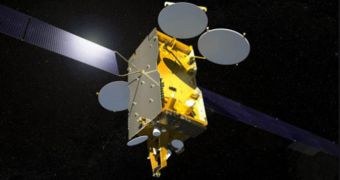Two days ago, the Russian Federal Space Agency (RosCosmos) launched a new telecommunications satellite. Shortly after reaching orbit, the spacecraft and its upper stage disappeared from radar. The US Space Surveillance Network found it yesterday, in an entirely different orbit.
The Express-AM4 satellite is a state-of-the-art instrument, which took $300 million to build. It weighs a total of 5,800 kilograms, and was designed to have a lifespan of more than 15 years.
The spacecraft was launched on August 18, aboard a Proton delivery system outfitted with a Breeze-M upper stage. Upon reaching orbit, the two separated from the rocket, and then from each other.
From that moment on, radars could no longer pick up signals from any of time. The US picked up signals from a piece of space debris, but it was later determined to be one of the auxiliary propellant tanks on the delivery system.
By mid-day August 19, the Americans detected the satellite moving in an unplanned orbit, with an apogee of 20,317 kilometers and a perigee of 1,007 kilometers. It was determined that the spacecraft was inclined 51.3 degrees to the Equator.
This orbit is not useful for the mission this satellite was supposed to complete. It needed to be injected into low-Earth orbit, and then moved to a geostationary orbit. Telecommunications satellites are usually placed in such orbits because they need to service a certain area.
At this point, officials from RosCosmos and Moscow-based Russian Satellite Communications Co. (RSCC), cannot say whether the mission is a complete bust or not. They are currently assessing whether it's possible to move the instrument to a useful orbit or not.
The issue is whether the satellites will have sufficient power to perform its function once the maneuvers associated with placing it in an useful orbit are concluded. Given the characteristics of its current path, experts estimate that it will take a lot of time and fuel for the shift to take place.
Express-AM4 is currently in danger of freezing, if it fails to open its solar arrays. Batteries will only last for another 48 hours, after which time the spacecraft will start to experience a fatal drop in temperature, Space reports.
“You're looking at a very large area in which the Breeze-M could have dropped off the satellite. Indications are that the Breeze-M was high enough at the time to permit the satellite to survive in orbit and generate solar power, even if its location is not optimal,” an unnamed Russian official said.
“But there is a real possibility that it would be salvaged, even if its operational life is reduced,” he added. Currently, the Russians are looking into sending new lines of code to the satellite, asking it to open its solar arras at least partially.

 14 DAY TRIAL //
14 DAY TRIAL //